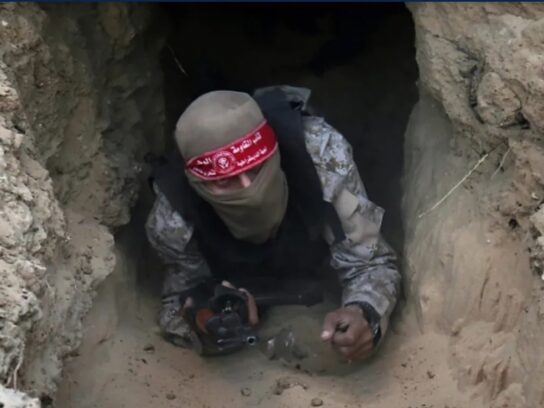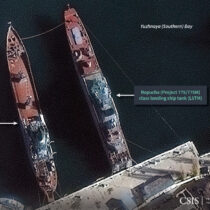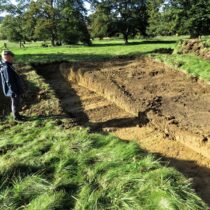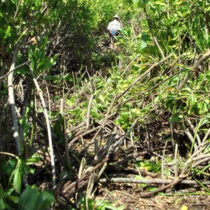
History of Tunnels Under Gaza
The tunnels under the Gaza Strip originated in the 1980s as smuggling routes between Gaza and Egypt, and expanded dramatically after the 2007 Egyptian-Israeli blockade of Gaza.
According to the RAND Corporation think tank, in 2014 Israeli intelligence was “caught flat-footed by the Hamas Gaza tunnels” that penetrated southeast into Israel, and allowed armed militants to successfully attack Israel Defense Forces (IDF) personnel and bases.
Since 2014, the underground network inside Gaza has expanded substantially. Hamas leader Yahya Sinwar claimed in 2021 that the group had 310 miles of tunnels under Gaza.
Types of Tunnels Under Gaza
There are six types of tunnels: economic/smuggling, offensive (that penetrate Israel), executive (for escaping high level officials), command/control centers, storage, and transit (linking different parts of the network). The deepest tunnel found to date was 230 feet below the surface, while the average was 66 to 98 feet deep.
The most common transit tunnels are about 6.5 feet high, 3.3 feet wide, with a 3-inch-thick concrete dome and sides. Many transit tunnels have electric and communications wiring. Entrances are often concealed by bushes and hidden trap doors, and many tunnels run under schools, mosques, hospitals and homes.
IDF Yahalom Special Engineering Battalion
Since 2014 the IDF has developed the “Yahalom” (“Diamond”) special engineering battalion with over 900 personnel, to undertake tunnel warfare. The battalion has specialists (often female) in “deciphering” (locating) tunnels using multiple intelligence sources, communications specialists, medics, geologists, explosive ordinance disposal experts, a designated “Samur” (“Weasel”) unit for underground fighting, demolition unit, heavy equipment digging unit, and a canine unit.
A Yahalom underground bunker near Gaza collects technical information from sensors stationed all along the border. These data are integrated with information from other sources, including signals intelligence, human intelligence, imagery intelligence, and measurement and signatures intelligence. Their tactics are classified but likely include:
- Seismic sensors. The IDF reportedly tried “400 sensor ideas to come up with 4 that might work.” In 2016 the US allocated $40 million of its Israeli military aid package to creating an “Underground Iron Dome” system using seismic sensors, to “detect, map and neutralize” cross-border tunnels. Two Israeli firms which worked on the aerial Iron Dome were contracted, and the US DoD would “receive prototypes, access to test sites, and rights to any intellectual property.”
- Other sensors. Other sensing options that the IDF may be using include ground penetrating radar, magnetometers, electromagnetic induction, electrical resistivity, thermal imagery, random drilling, microphones, aerial sensors, and gravity sensors. Unfortunately, many of these technologies can yield false positives. For example, in 2019 an IDF officer played a recording at a research conference which sounded exactly like an underground jackhammer being used to drill a tunnel. In fact, the sound was from a 2-inch-long male mole cricket trying to attract a mate!
- Acoustical analysis. There is extensive literature on locating and analyzing tunnels, using acoustic waves. These waves are generated by small, controlled explosions above ground. Such analyses can determine the size and shape of the tunnels, the surrounding soil composition, and whether the walls are made of concrete or other substances.
- Counter-tunnels. Tunnel warfare since the Middle Ages has often involved counter-tunnels, in which sappers dig tunnels that approach the original tunnels. Usually, the goal here is to set off explosions that kill the soldiers in the original tunnels, but the new tunnels can also be used to launch attacks and hostage rescues.
- Offensive attacks. Offensive options for killing or disabling terrorists in tunnels include flamethrowers, thermobaric weapons, toxic gases, tear gases, flooding, and close quarter battle.
- Exploiting air shafts. Videos of the 2014 Gaza tunnels showed that some (and perhaps many) had narrow, vertical ventilation shafts leading to the surface, to allow CO2 to escape and fresh air to enter. These shafts (when found) are a weak point, which can be exploited by lowering microphones to listen for the voices of terrorists or hostages, lowering 1-cm-wide video feed cameras that can rotate 360 degrees, and introducing sleeping gases or smoke.
October 2002 Hostage Rescue Non-Lethal Approach
A non-lethal approach to hostage rescue that was botched by the Russians may be relevant. In Moscow in October 2002 the North-East Theater was taken over by 50 armed Chechens, who held the audience hostage with guns and over two tons of explosives. After three days the Russian authorities gassed the theater with “a mixture of Fentanyl derivates.” All the terrorists were killed or captured, and the explosives were not detonated.
Sadly, the Fentanyl mixture was apparently too powerful, and of the 800 hostages, 129 (16%) died. But more than 100 of those individuals died due to the total lack of immediate medical care, which should have been quickly delivered by Russian authorities to the victims. With a proper dose of a better gas, and competent, carefully planned medical care, experts estimate that only about 20 (2.5%), or less, of the hostages would have died.
Underground Warfare
There is only one relevant major book, Underground Warfare: Trends, Challenges and Opportunities (2018), by Dr. Daphne Richemond-Barak. This book lays out the history of tunnel warfare, its status under international law, types of tunnels, and counter-tunnel strategy, tactics and future. Richemond noted that tunnel warfare was on the increase, especially in the Middle East and Asia. She predicted that the IDF had managed to catch up with Hamas in tunnel warfare, but worried that Hamas was innovative and might spring surprises in the future.
She was right.
The “Underground Iron Dome” may have been foiled by the quiet digging tunnel technology used by Hamas. According to one digger turned informant interviewed in 2013, “The drilling is done via a mechanical device, not an electric one, to avoid making noise. It uses a pedal-powered chain, similar to a bicycle chain. The digger lies on his back and pedals with his feet.”
The tunnel diggers also reportedly “know where the security fence sensors are located and know how to jam them, including the unmanned aircraft that hover above Gaza around-the-clock and take X-ray images of the Earth’s surface.”
October 7 Massacre Key Failure
A key failure in the October 7 massacre was that at the insistence of right-wing Israeli settlers in the West Bank, many of the IDF soldiers watching the Gaza Strip were temporarily moved to the West Bank during the holiday of Simchat Torah. This disastrous decision was approved by IDF generals, in line with the policies of the Prime Minister.
The fact that the PM, IDF and Yahalom battalion, with all their intelligence and technologies, were not able to see this attack coming, is astounding. As Dr. Richemond-Barak says, “It’s incredible how many countries are fooled over and over by attacks from underground tunnels. They just don’t seem to learn their lessons.”
Photos courtesy Lew Toulmin
- 1. Map of Israel, right, showing the Gaza Strip in the inset. The Strip is about 25 miles long and 4 to 8 miles wide.
- 2. Map of Gaza showing 2014 Hamas tunnels in red and destroyed offensive tunnels in black.
- 3. The logo of the “Yahalom” (Diamond) battalion of the Israel Defense Forces (IDF), which specializes in tunnel warfare. Note the diamond and the tunneling device, which looks like a crown with a screwdriver, at the top.
- 4. A Hamas fighter emerging from a Gaza tunnel.
- 5. A Gaza transit tunnel, in the foreground, opens into a larger command tunnel in the distance. Note the attractive tiled floor.
- 6. A Gaza tunnel exposed by an explosion from above. Note the very sandy soil, which is very dangerous to dig in. Cave-ins have killed at least 160 of the 1500 diggers, who are paid $250 to $400 USD per month, a very high salary for Gaza, which has high unemployment and low wages. Some of the diggers have been children.
- 7. Nikki Haley, US Ambassador to the UN, getting a tour in 2017 of an exposed offensive Hamas tunnel into Israel.
- 8. In November 2019 the US Army published the 228-page manual Subterranean Operations. (See https://irp.fas.org/doddir/army/atp3-21-51.pdf.) While useful, it does not appear to draw much on the Gaza-Hamas experience. This illustration is one of the few from the manual that shows anything close to the Hamas sub-urban approach.
- 9. An IDF drilling machine, used for random drilling to detect Hamas tunnels. Unfortunately, over the last decade it has only been possible to use this machine on the Israeli side of the border, to detect offensive tunnels.











































Comments are closed.